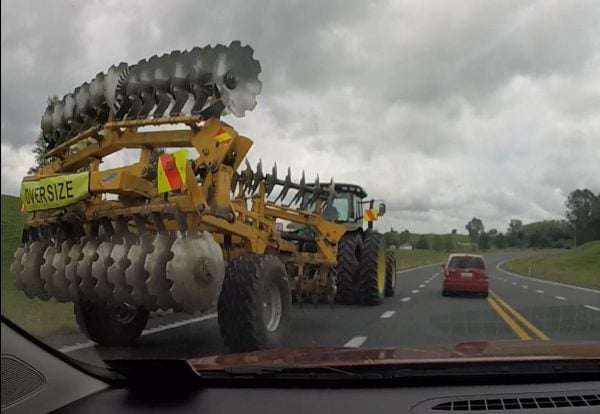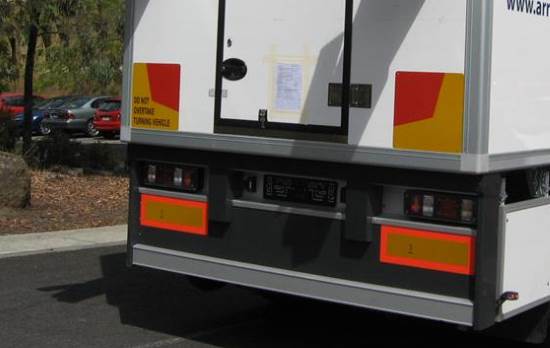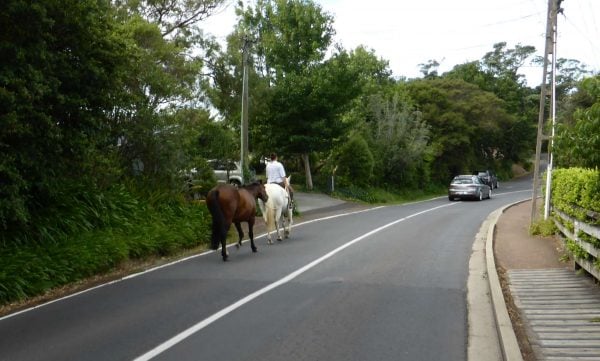Overtaking or passing means getting by a vehicle ahead of you that is either travelling slower or has stopped. The reasons for not overtaking are different for different types of road.

Road markings often indicate to you when you definitely should not overtake (yellow centre line, either solid or dashed), when you need to exercise much more caution than usual (solid white centre line), or where the road mostly has good visibility but you still need to ensure it is safe (dashed white centre line). See this article on the centre lines on roads for images and more explanation.
Single-lane unmarked road
This is a narrow road without a centre dividing line.
Don’t overtake:
- When you would force the other vehicle onto the verge, or you would have to drive on the verge
- When you can’t see at least 100m of clear road ahead of you when you have finished overtaking
- Where there are other hazards
- When you would exceed the speed limit
- When you are approaching an intersection
- When the vehicle ahead is indicating right
- By following another vehicle past a long vehicle (the vehicle ahead may need to abort the manoeuvre if a hazard develops ahead)
- Where the road surface might cause problems for you or the vehicle you are overtaking (e.g. very loose gravel which is in ridges and it’s safest to not drive on the ridges).
Do overtake:
- When the vehicle ahead has clearly signalled that they are pulling over to let you past (this can be using their indicator, entering a passing lane or slow vehicle bay, or waving you by)
- If the road widens and it’s safe to do so.
Single-lane marked road
This is a road with one lane in either direction.
Don’t overtake:
- When there is a centre yellow line on your side and you must cross it to get past (there are exceptions to this when a vehicle is stationary on the side of the road and there’s no other way around)
- When the vehicle is indicating right (you can under-take, if safe, though)
- When you are approaching an intersection where vehicles could pull out (these are typically indicated by a solid white line with a break in it where intersection is)
- When you would exceed the speed limit
- When you can’t see at least 100m of clear road ahead of you when you finish your overtaking manoeuvre
- When another vehicle behind you is already overtaking
- When you are both accelerating from a lower speed limit (unless you are certain that the vehicle you are overtaking won’t be able to accelerate as quickly as you and also won’t be travelling as quickly as you once it reaches its desired speed)
- When you don’t have enough power to get past safely and in a reasonable distance (e.g. on a steep uphill gradient)
- When you would cause the other vehicle to brake or swerve to avoid a collision
- When there are vehicles parked on the side of the road ahead which would mean that the vehicle you’re following also has to move right to get past them
- When there are cyclists or pedestrians ahead on your side of the road and the vehicle you’re following also has to move right to get past them
- When the vehicle has a pilot vehicle because it’s large
- At a pedestrian crossing (whether the driver ahead is maintaining their speed, is slowing down or has stopped).
- When waiting at traffic lights, unless you’re a motorbike filtering to the front of the queue.
- When you see a person with impaired vision waiting to cross the road
- By following another vehicle past a long vehicle (the vehicle ahead may need to abort the manoeuvre if a hazard develops ahead)

Multi-lane roads
When there are two or more lanes in either direction, overtaking is safer, but there are still scenarios where you shouldn’t overtake.
Don’t overtake:
- When you are approaching the end of a passing lane if you can’t make it before the passing lane closes
- When you are approaching a closing lane (e.g. due to roadworks), or where there are roadworks
- When you can’t overtake without exceeding the speed limit
- When another vehicle is overtaking you
- When you can’t overtake without holding up others behind you (e.g. overtaking a b-train or semitrailer at 1km/h more than they are doing)
- Coming up to a reduction in the speed limit
- Where you need to use a lane that you are not permitted to use (e.g. a bus lane), unless it’s because the lane you are in is blocked by a turning or parked vehicle
- Using the median strip, unless it’s to pass a vehicle that is stopped to turn left or waiting to park
- Using the hard shoulder of a motorway.
Scenarios where getting past a slower vehicle could be safe
There are some opportunistic scenarios you can take to get past a slower vehicle without there being a passing lane or clear traffic ahead.
Consider making this manouevre:
- Where there are two lanes of a roundabout going straight ahead (but take care – this is more about your acceleration through the roundabout after giving way, or where the vehicle you want to overtake is braking over-cautiously)
- Where there are two lanes at traffic lights (but plan ahead so you’re not changing lanes at the last minute when the painted lines are solid and you’re not causing the other vehicle to take evasive action). Bear in mind that if you’re at the head of the queue for this purpose that when taking off smartly when the light turns green, be sure to check no one is running the red light!
- On the left where a vehicle is indicating to turn right and has moved to the right (or vice versa if you drive on the right in your country)
- When you can filter safely on a motorbike
- On the left when the right-hand lane is backed up (or vice versa if you drive on the right)
Overtaking should always be done at a safe speed. This means it’s under the speed limit and appropriate for the road conditions. Be aware of overtaking when approaching road features that require you to brake. Take care overtaking a horse and rider as not to spook the horse.

Other scenarios
You are not permitted to overtake within 60m of the approach of a railway level crossing.
When a police officer has instructed you not to overtake, or is directing traffic.

